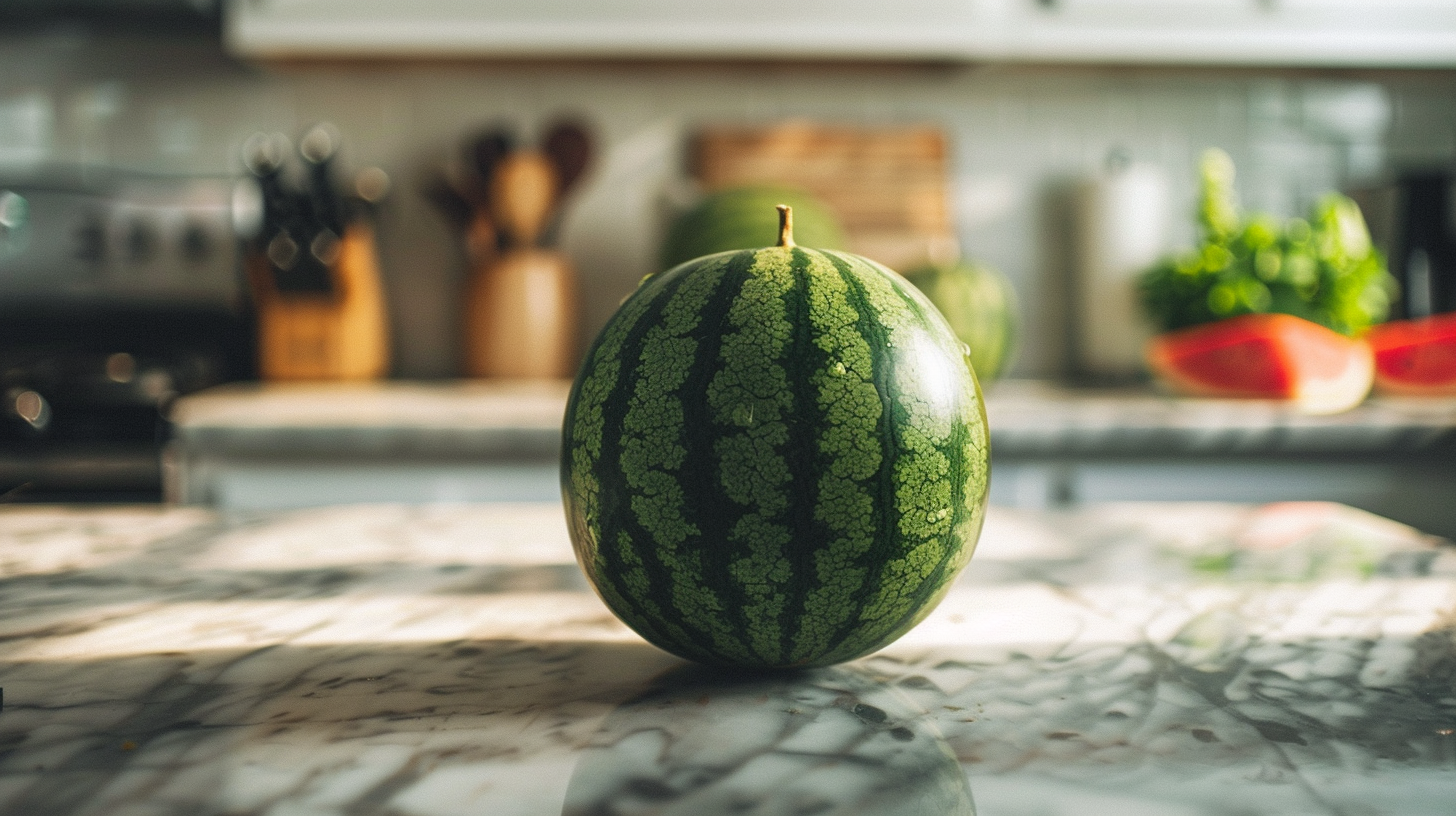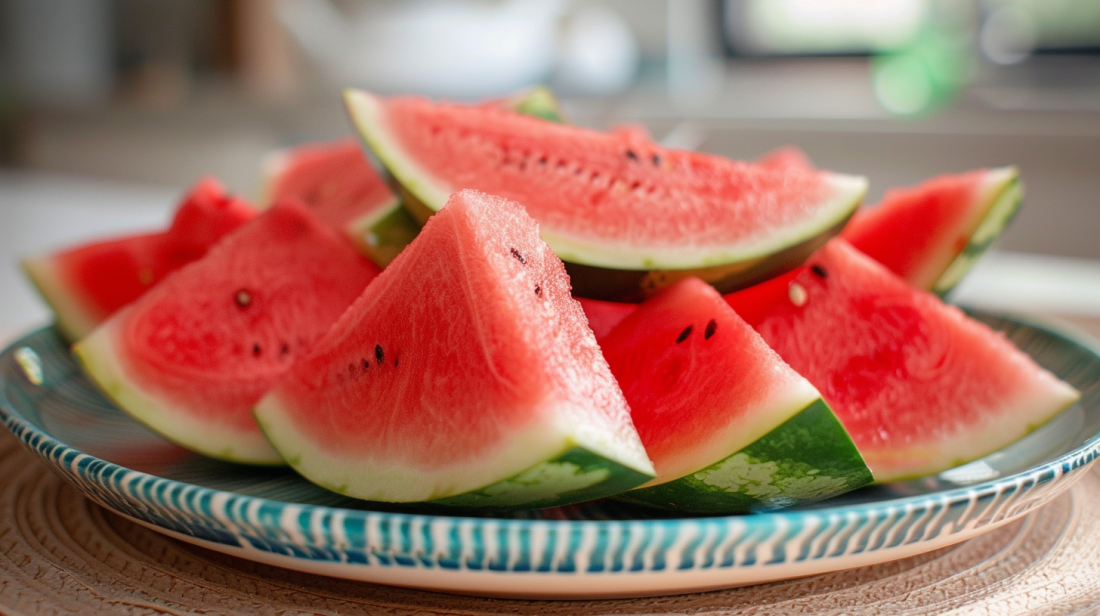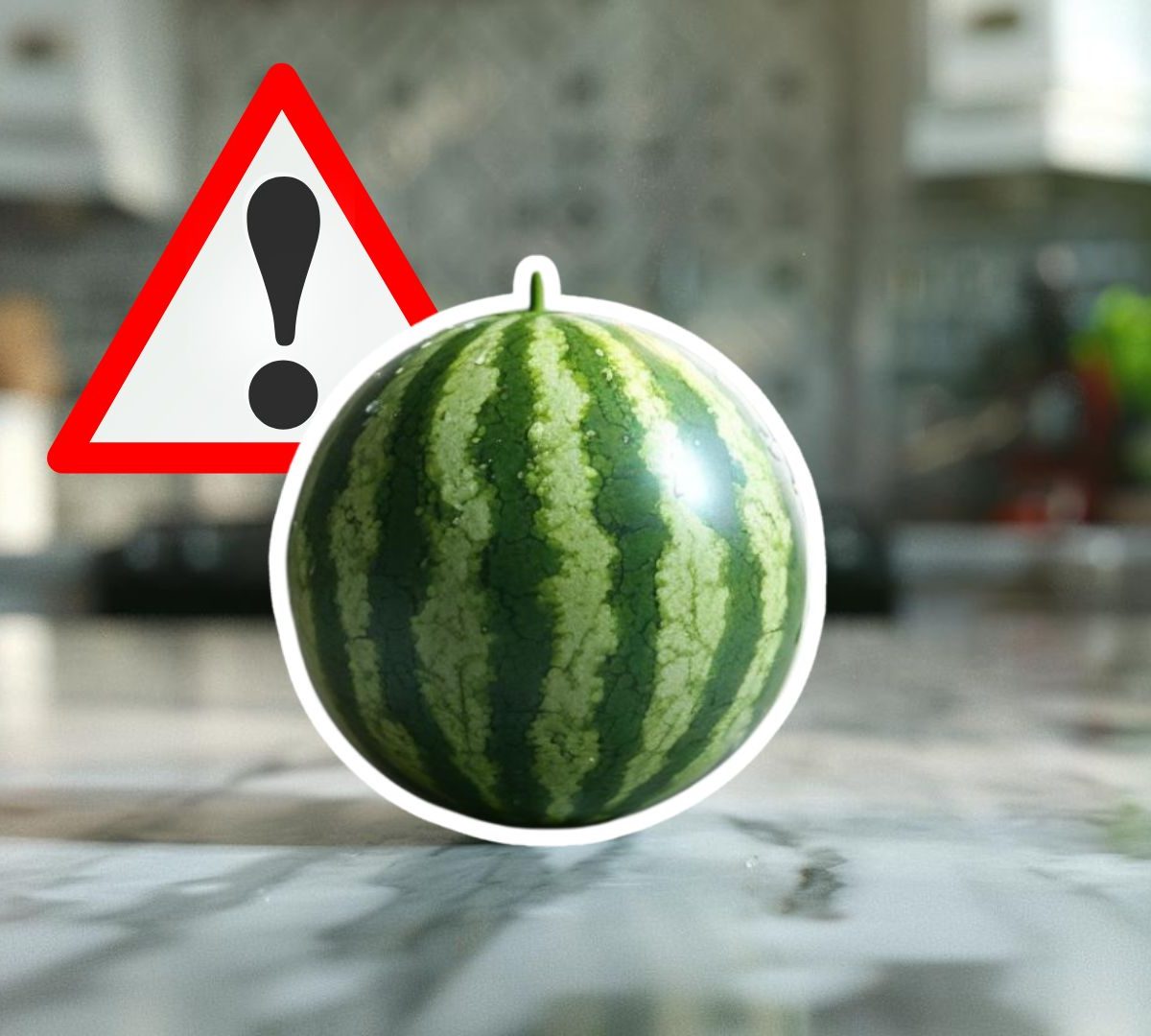Imagine biting into a slice of watermelon only to discover it tastes off or has a strange texture. Many of us have had this disappointing experience.
Choosing a perfectly ripe and sweet watermelon can be tricky, but knowing the signs of a bad one can help you avoid an unpleasant surprise.
In this blog post, we’ll explore 13 clear indicators that watermelon has gone bad so you can confidently pick the best one every time.
From examining the exterior and checking for mold to assessing the smell, texture, and taste, we’ll cover all the key points to ensure you always enjoy a delicious and refreshing watermelon.
Signs to Tell if Watermelon is Bad

Visual Signs
When selecting a watermelon, visual inspection is crucial. Before even picking up a watermelon, you can spot signs that indicate it might not be suitable for consumption.
Here Are Some Key Visual Cues to Watch out For:
1. Soft Spots and Bruises
One of the most common signs of a bad watermelon is the presence of soft, spongy spots. These areas are usually caused by rough handling or improper storage during transport.
Soft spots often signal underlying decay or spoilage, so avoiding watermelons with visible bruising is best.
2. Odd Growth and Mold
Look for any unusual growths or mold on the watermelon’s surface. Dark-colored spots, fuzzy patches, or white, green, or black spores, especially around the stem area, are serious red flags.
These signs indicate significant spoilage and potential health risks, so steer clear of watermelons with visible mold.
3. Shiny or Slimy Skin
A watermelon with a shiny or slimy exterior suggests that decomposition has begun. This is often caused by excess moisture and is a telltale sign that the fruit is past its prime.
The skin should be matte and slightly dull, not overly glossy or slick.
4. Discoloration
Uneven coloring or faded patches on the watermelon’s skin can indicate age, improper storage, or internal issues.
While discoloration doesn’t always mean the fruit has spoiled, it can suggest that the watermelon is not at peak freshness. Look for consistent coloring across the entire surface.
When inspecting watermelons at the store or market, take a moment to examine the entire fruit. Press the surface to check for soft spots, and avoid watermelons with visible bruising. Remember to turn the watermelon over and inspect all sides, as defects can sometimes be hidden on the bottom or rear of the fruit.
5. Watermelon Inspection Checklist Table
| Sign | What to Look For | How to Test | What to Avoid |
|---|---|---|---|
| Soft Spots and Bruises | Soft, spongy areas on the rind | Gently press the surface of the watermelon | Watermelons with visible bruises or softness |
| Odd Growth and Mold | Dark spots, fuzzy patches, white, green, or black spores | Visually inspect, especially around the stem area | Watermelons with any visible mold |
| Shiny or Slimy Skin | Glossy or wet-looking exterior | Look and touch to check for sliminess | Overly shiny or slimy watermelons |
| Discoloration | Uneven coloring or faded patches | Observe the color uniformity across the surface | Watermelons with significant discoloration |
| Lack of Firmness | Rind that yields too easily under pressure | Press gently against the rind | Watermelons that feel mushy or too soft |
| Cracks Inside | Internal cracks around seeds or flesh | Cut open and inspect the inside | Watermelons with visible internal cracks |
| Dry or Gritty Flesh | Less moisture and rough texture | Taste a sample if possible | Watermelons that taste dry or are grainy |
| Unpleasant Odor | Sour or fermented smell | Smell the area where the stem was attached | Watermelons with a bad smell |
| Unpleasant Taste | Bland, sour, or fizzy taste | Sample the fruit if possible | Watermelons that don’t taste sweet or crisp |
Texture and Firmness
After checking the watermelon’s exterior, let’s examine another crucial aspect – its texture and firmness. These factors not only affect the taste but also play a role in the overall safety of the fruit.
Here’s What You Need to Know:
5. Lack of Firmness
A fresh watermelon should have a firm rind that doesn’t give way when pressed gently. If the rind feels soft or mushy, it’s a sign that the watermelon is overripe or has started to decay internally.
Always give the watermelon a light squeeze before purchasing.
6. Cracks Inside the Watermelon
Once you cut open the watermelon, examine its internal structure closely.
If you notice any cracks or dents around the seeds or in the flesh, it could indicate that the watermelon has aged past its prime or was stored improperly, affecting taste and texture.
7. Dry or Gritty Flesh
The flesh of a good watermelon should be crisp, juicy, and slightly firm. If the flesh feels dry or has a gritty texture, it’s a sign that the watermelon has lost moisture over time, impacting the flavor and making the texture less appealing.
To test for good texture and firmness before purchasing, gently press against the watermelon’s rind. It should feel solid and not give way under slight pressure.
If possible, ask for a sample slice at the point of purchase to observe the texture and taste directly. This will give you the best idea of its freshness and quality.
Smell and Taste
Smell and taste are crucial indicators of a watermelon’s freshness and edibility, often serving as the most direct way for consumers to assess the quality of the fruit before making a purchase.
8. Off-Putting Odor
A healthy watermelon should have a mildly sweet or neutral smell. An unpleasant, sour, or fermented odor indicates that the watermelon has started to spoil internally and is no longer safe to consume.
Trust your nose – if the smell is off, it’s best to avoid that watermelon.
9. Unpleasant Taste
A fresh watermelon should taste sweet and slightly crisp. If the taste is bland, sour, unusually fizzy, or lacks sweetness, it suggests that the sugars inside the fruit have begun to ferment, leading to spoilage.
Any deviation from the expected taste is a red flag that the watermelon is no longer at its prime.
10. Lack of Juiciness
A ripe watermelon should be juicy and hydrating. Suppose you bite a watermelon and find it lacks juiciness or feels dry.
In that case, it can negatively impact the taste and texture, detracting from the overall eating experience and indicating that the watermelon is past its prime.
To test the smell before buying, try smelling the watermelon at the spot where the stem was attached. This area can provide clues about the internal condition of the fruit. If possible, ask for a sample taste at the market to assess the flavor directly, or consider purchasing smaller quantities or pre-cut slices if you’re unsure about the quality of larger fruits.
Sound
Sound is a quick and effective method for assessing the ripeness and freshness of watermelon.
This traditional technique, widely used by experienced fruit buyers, is based on the changes in acoustic properties as the watermelon ages.
11. Dull Sound When Tapped
When you tap a watermelon, it should produce a hollow, resonant sound if the fruit is fresh.
A dull or flat sound indicates the watermelon is overripe or beginning to spoil as the texture deteriorates.
To perform the sound test, use the palm of your hand or your knuckles to gently tap the watermelon and listen closely to the sound quality.
A fresh watermelon produces a deep, hollow sound, while an overripe or spoiled one has a dull, flat sound.
However, with practice, you can distinguish between the desired resonance and the undesired dullness.
Shelf Life and Storage
Proper storage and awareness of shelf life are crucial factors in maintaining the freshness and edibility of watermelons, significantly influencing their longevity and quality.
12. Exceeding Storage Time
Pay close attention to the shelf life of watermelons, especially for pre-cut fruits, which have a much shorter edible period than whole watermelons.
Consuming watermelon close to or past the sell-by date increases the risk of eating spoiled fruit, which can lead to foodborne illnesses.
Always check the expiration date and use your best judgment when assessing freshness.
13. Improper Storage
Storage conditions play a significant role in the rate of spoilage. Watermelons exposed to warm temperatures or excessive moisture can deteriorate much faster than those stored in ideal conditions.
To prevent premature spoilage, store whole watermelons in a cool, dry place away from direct sunlight, and refrigerate cut watermelons promptly in an airtight container.
To maximize the shelf life of your watermelon, find a cool, dry spot in your home, such as a basement or pantry, where the temperature remains consistent.
Avoid placing them in direct sunlight or near heat sources. Once cut, store watermelon pieces in an airtight container in the refrigerator and consume them within 3-5 days for the best quality and safety.
Cutting and Preparing Watermelon for Extended Freshness

Proper cutting and preparation techniques can help extend the freshness of your watermelon and ensure you get the most out of this delicious fruit.
- Wash Before Cutting: Always wash the watermelon’s exterior with running water and a clean brush before cutting it open. This helps remove any dirt, bacteria, or potential contaminants on the surface, preventing them from being transferred to the flesh when you slice it.
- Use a Sharp Knife: When cutting the watermelon, use a sharp, clean knife to make precise cuts. A dull knife can damage the flesh more, leading to faster spoilage.
- Cut into Appropriate Sizes: If you don’t plan on consuming the entire watermelon at once, cut it into manageable portions that you can easily store and consume within a few days. Smaller pieces have a larger surface area exposed to air, which can lead to quicker deterioration.
- Remove Seeds: Remove the seeds from the watermelon flesh before storing them. This can help prevent the seeds from affecting the texture and flavor of the watermelon over time.
- Store in Airtight Containers: Place the cut watermelon pieces in airtight containers or wrap them tightly with plastic wrap before refrigerating. This helps prevent air exposure and slows down the spoilage process.
By following these cutting and preparation tips, you can help your watermelon stay fresh for longer, allowing you to enjoy its sweet, juicy goodness for days after cutting.
Nutritional Benefits of Watermelon

Beyond its refreshing taste, watermelon offers a range of nutritional benefits that make it a valuable addition to a healthy diet.
Here are some key reasons why choosing a fresh, ripe watermelon matters:
- Hydration: Watermelon is composed of over 90% water, making it an excellent source of hydration. Eating watermelon can help keep you refreshed and replenish lost fluids, especially during hot summer months.
- Nutrient-Dense: Watermelon is packed with essential vitamins and minerals, such as vitamin C, vitamin A, potassium, and magnesium. These nutrients support various bodily functions, from immune health to muscle and nerve function.
- Antioxidants: Watermelon contains powerful antioxidants like lycopene, beta-carotene, and vitamin C. These compounds help protect your cells from damaging free radicals associated with various chronic diseases and aging.
- Digestive Health: Watermelon’s high water content and fiber can support digestive health by promoting regular bowel movements and preventing constipation.
- Heart Health: The lycopene in watermelon has been linked to improved heart health, as it may help lower inflammation and reduce the risk of heart disease.
By choosing a fresh, ripe watermelon, you ensure that you get the maximum nutritional benefits this fruit offers.
Consuming spoiled or overripe watermelon diminishes its taste and texture, as well as its nutrient content and potential health benefits.
Nutritional Benefits Table
| Nutrient | Content in Fresh Watermelon (per 100g) | Content in Spoiled Watermelon (per 100g) | Impact of Spoilage |
|---|---|---|---|
| Water | 91.5 g | 91 g | Slight decrease in water content |
| Calories | 30 kcal | 28 kcal | Minor decrease due to breakdown of sugars |
| Vitamin C | 8.1 mg | 5 mg | Decreased vitamin content |
| Vitamin A | 569 IU | 400 IU | Decrease in antioxidant content |
| Lycopene | 4532 µg | 3500 µg | Significant reduction in antioxidant content |
| Beta-carotene | 303 µg | 200 µg | Decreased availability of Vitamin A precursor |
| Potassium | 112 mg | 100 mg | Slight decrease |
Conclusion
Spotting the signs of a bad watermelon is crucial for enjoying a sweet, refreshing experience and avoiding potential health risks.
These indicators, from visual cues like soft spots and discoloration to off-putting smells and tastes, help you make an informed choice.
Remember to inspect the watermelon’s firmness, listen for a hollow sound when tapped, and be mindful of shelf life and storage conditions.
Proper cutting and preparation techniques can also help extend the freshness of your watermelon while choosing ripe, fresh fruit ensures the maximum nutritional benefits.
By following these guidelines, you’ll be well-equipped to select the perfect watermelon every time.
So, the next time you’re at the market or grocery store, put your newfound knowledge to the test and choose a watermelon that will delight your taste buds and support your overall health.
With a keen eye and these helpful tips, you’ll never have to settle for a subpar watermelon again.
Frequently Asked Questions
How Long Does It Take to Get Sick from Bad Watermelon?
Depending on the type of contaminant, symptoms of foodborne illness from bad watermelon can appear within a few hours to a couple of days after consumption.
Is It Safe to Eat Overripe Watermelon?
Overripe watermelon is generally safe to eat but may have a mealy texture and a less appealing taste. Discard if it shows signs of spoilage.
Can You Get Food Poisoning from Watermelon?
Yes, watermelon can cause food poisoning if it’s contaminated with harmful bacteria like Salmonella or E. coli, often due to improper handling or storage.






